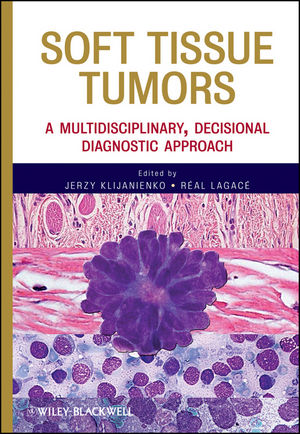Soft Tissue Tumors: A Multidisciplinary, Decisional Diagnostic ApproachISBN: 978-0-470-50571-7
Hardcover
448 pages
April 2011, Wiley-Blackwell
 |
||||||
Preface.
Acknowledgments.
Contributors.
1 Clinical approach in soft tissue tumors (Francois Goldwasser).
1.1 Epidemiology.
1.2 Clinics and clinical profiles.
1.3 Clinical differential diagnosis.
1.4 The importance of molecular diagnosis and its perspectives.
1.5 Treatment strategies.
2 Radiological diagnostic approach in soft tissue tumors (Hervé Brisse).
2.1 Introduction.
2.2 Patient management.
2.3 Imaging techniques.
2.4 Radiologic characterization.
2.5 Tumor biopsy.
3 Sampling procedure, fine needle aspiration (FNA), and core needle biopsy (CNB) (Henryk A. Domański).
3.1 Advantages and limitations of FNA and CNB in soft tissue lesions.
3.2 Techniques of FNA and CNB as applied to soft tissue lesions.
3.3 Processing the FNA and CNB samples and preparation of the FNA specimen for ancillary techniques.
3.4 Challenges in the FNA and CNB of soft tissue.
3.5 Complications of FNA and CNB of soft tissue.
4 Ancillary techniques.
4.1 Immunocytochemistry (Carlos Bedrossian).
4.2 Immunohistochemistry (Réal Lagacé).
4.3 Genetic Techniques (Jérôme Couturier).
4.4 Grading of soft tissue tumors (Réal Lagacé).
4.5 Future investigations of ancillary techniques (Stamatios Theocharis).
5 Principal aspects in fine needle aspiration and core needle biopsies (Jerzy Klijanienko and Réal Lagacé).
5.1 Normal tissue.
5.2 Cytologic classification of soft tissue tumors based on the principal patterns.
5.3 Diagnostic accuracy of FNA in soft tissue tumors.
5.4 Smear composition and the differential diagnosis of soft tissue tumors.
6 Particular aspects (Jerzy Klijanienko and Réal Lagacé).
6.1 Low-grade spindle cell tumors.
6.1.1 Fibromatoses and Desmoids.
6.1.2 Nodular Fasciitis.
6.1.3 Dermatofibrosarcoma Protuberans.
6.1.4 Benign Fibrous Histiocytoma (Cellular and Atypical Variants).
6.1.5 Solitary Fibrous Tumor.
6.2 Tumors with fibrillary stroma.
6.2.1 Benign Peripheral Nerve Sheath Tumors (Schwannoma, Ancient Schwannoma and Neurofibroma).
6.2.2 Low-Grade Malignant Peripheral Nerve Sheath Tumor.
6.3 Malignant spindle cell tumors.
6.3.1 Leiomyosarcoma.
6.3.2 Synovial Sarcoma.
6.3.3 Fibrosarcoma.
6.3.4 Malignant Fibrous Histiocytoma Storiform Pattern.
6.3.5 Malignant Peripheral Nerve Sheath Tumor.
6.3.6 Spindle Cell Angiosarcoma.
6.3.7 Kaposi Sarcoma.
6.4 Myxoid tumors.
6.4.1 Myxoid Liposarcoma (With or Without Round or Spindle Cells).
6.4.2 Myxofibrosarcoma.
6.4.3 Myxoid Leiomyosarcoma.
6.4.4 Myxoma and Cellular Myxoma.
6.4.5 Chordoma.
6.4.6 Extraskeletal Myxoid Chondrosarcoma.
6.5 Atypical lipomatous tumors.
6.5.1 Well-Differentiated liposarcoma / Atypical Lipoma.
6.5.2 Spindle Cell and Pleomorphic Lipoma.
6.6 Epithelioid tumors.
6.6.1 Epithelioid Sarcoma.
6.6.2 Gastrointestinal Stromal Tumor (GIST)/Epithelioid Leiomyosarcoma.
6.6.3 Epithelioid Angiosarcoma.
6.6.4 Granular Cell Tumor.
6.6.5 Rhabdoid Tumor.
6.6.6 Alveolar Soft Part Sarcoma.
6.6.7 Clear Cell Sarcoma.
6.6.8 Malignant Melanoma and Metastases.
6.7 Pleomorphic sarcomas.
6.7.1 Pleomorphic Malignant Fibrous Histiocytoma.
6.7.2 Pleomorphic Liposarcoma.
6.7.3 Pleomorphic Leiomyosarcoma and Rhabdomyosarcoma.
6.7.4 Extraskeletal Osteosarcoma.
6.7.5 Pleomorphic Malignant Peripheral Nerve Sheath Tumor.
6.8 Round cell sarcomas.
6.8.1 Embryonnal and Alveolar Rhabdomyosarcoma.
6.8.2 Ewing Sarcoma/Peripheral Neuroectodermal Tumor.
6.8.3 Desmoplastic Small Round Cell Tumor.
6.8.4 Extraskeletal Mesenchymal Chondrosarcoma.
6.8.5 Poorly Differentiated Synovial Sarcoma.
Index.



